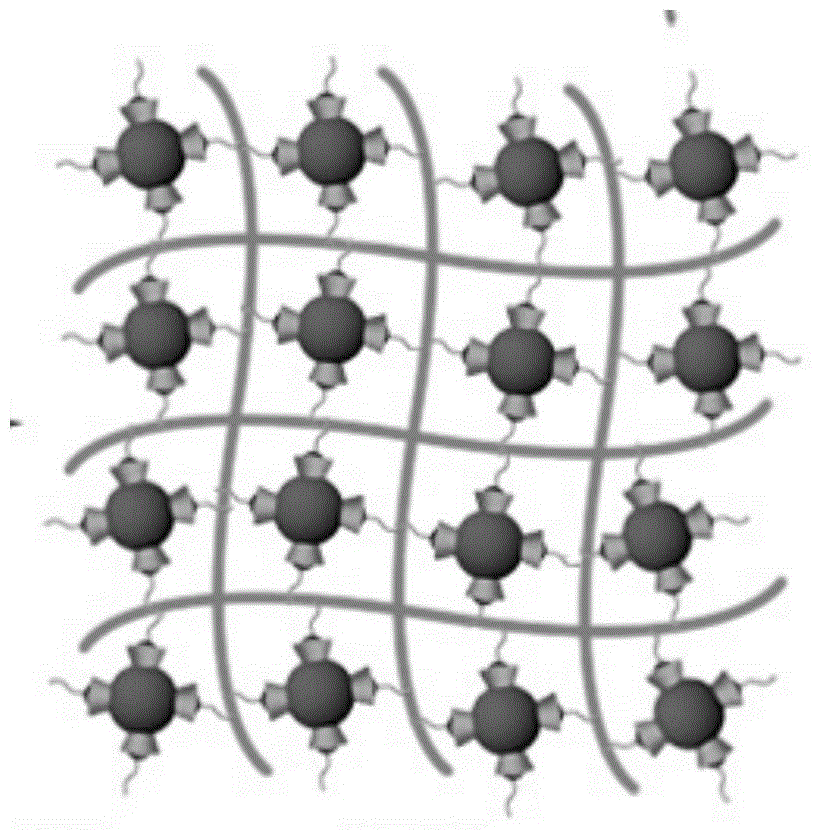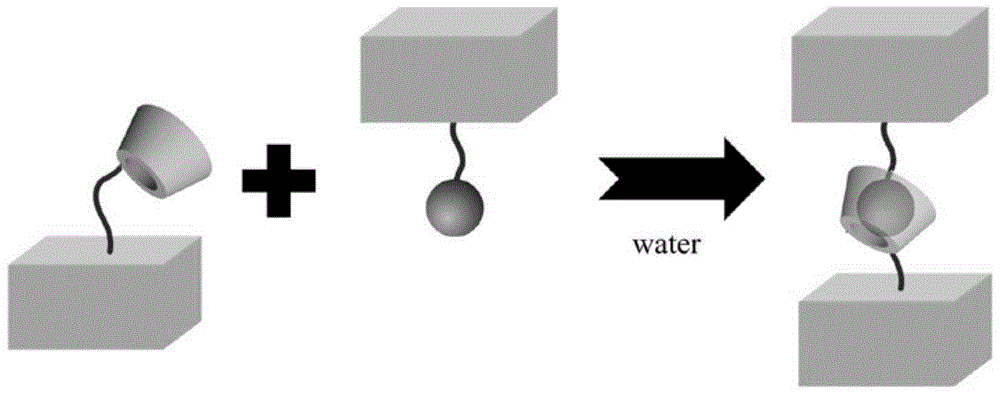Self-healing organic/inorganic nanoparticle hybrid material and preparation method thereof
A technology of inorganic nanoparticles and hybrid materials, which is applied in the field of organic-inorganic hybrid materials and its preparation, can solve problems such as poor mechanical strength, and achieve the effect of strong self-healing recovery ability
- Summary
- Abstract
- Description
- Claims
- Application Information
AI Technical Summary
Problems solved by technology
Method used
Image
Examples
Embodiment 1
[0024] Dissolve adamantyl acrylate in DMSO solution (concentration: 8%), and β-cyclodextrin-modified ferroferromagnetic particles are dispersed in water (concentration: 2%). Then the two were mixed (the molar ratio of adamantane to β-cyclodextrin was 1:1) and stirred for 5 hours, and the adamantyl acrylate not involved in the assembly was removed by centrifugation. The assembled adamantyl acrylate / β-cyclodextrin-ferric iron tetroxide and butyl acrylate in a weight ratio of 1:5, using tetrahydrofuran as a solvent, AIBN as an initiator, ethylene glycol dimethacrylate (EGDMA ) is a cross-linking agent for copolymerization and cross-linking, and the reaction time is 12 hours. After the reaction is completed, the solvent is removed by vacuum drying for 40 hours, and the polyacrylic acid-adamantane / β-cyclodextrin-ferric oxide material can be obtained.
[0025]The polyacrylate / β-cyclodextrin-ferric oxide was cut in half, and then the cross-section was gently closed. After 0.5 hours,...
Embodiment 2
[0027] Vinyl azobenzoate was dissolved in DMSO solution (concentration: 3%), and α-cyclodextrin-modified graphene was dispersed in water (concentration: 5%). Then the two were mixed (the molar ratio of azobenzene to α-cyclodextrin was 1:1) and stirred for 3 hours, then centrifuged to remove vinyl azobenzoate that did not participate in the assembly. The assembled vinyl azobenzoate / α-cyclodextrin-graphene and hydroxyethyl acrylate are in a weight ratio of 1:3, using tetrahydrofuran as a solvent, AIBN as an initiator, and ethylene glycol dimethacrylate ( EGDMA) is cross-linking agent, carries out copolymerization and cross-linking, and the reaction time is 15 hours. After the reaction is completed, the solvent is removed by vacuum drying for 40 hours to obtain a polyacrylate-polyvinyl azobenzoate / α-cyclodextrin-graphene material.
[0028] The polyacrylate-polyvinyl azobenzoate / α-cyclodextrin-graphene was cut in half, and then the cross-section was gently closed. After 1 hour, t...
Embodiment 3
[0030] Ferrocene-modified sodium alginate (substitution degree: 8%) was dissolved in aqueous solution (concentration: 5%), and β-cyclodextrin-modified graphene was dispersed in water (concentration: 5%). Then the two were mixed (the molar ratio of ferrocene to β-cyclodextrin was 0.4:1) and stirred for 10 hours, then dialyzed for 48 hours to remove sodium alginate not involved in assembly. Concentrate the above-mentioned liquid after dialysis to remove most of the water, and then add 10% calcium chloride as a physical cross-linking agent to obtain sodium alginate-ferrocene / β-cyclodextrin-graphene gel.
[0031] The sodium alginate-ferrocene / graphene-β-cyclodextrin was cut in half, and then the cross-section was gently closed. After 5 hours, the material healed. The tensile strength after healing was 69% of the original strength. Self-healing can be repeated many times (cut and heal more than 3 times at the same site, and the tensile strength after healing is more than 50% of th...
PUM
| Property | Measurement | Unit |
|---|---|---|
| size | aaaaa | aaaaa |
Abstract
Description
Claims
Application Information
 Login to View More
Login to View More - Generate Ideas
- Intellectual Property
- Life Sciences
- Materials
- Tech Scout
- Unparalleled Data Quality
- Higher Quality Content
- 60% Fewer Hallucinations
Browse by: Latest US Patents, China's latest patents, Technical Efficacy Thesaurus, Application Domain, Technology Topic, Popular Technical Reports.
© 2025 PatSnap. All rights reserved.Legal|Privacy policy|Modern Slavery Act Transparency Statement|Sitemap|About US| Contact US: help@patsnap.com


